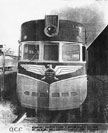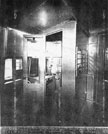|
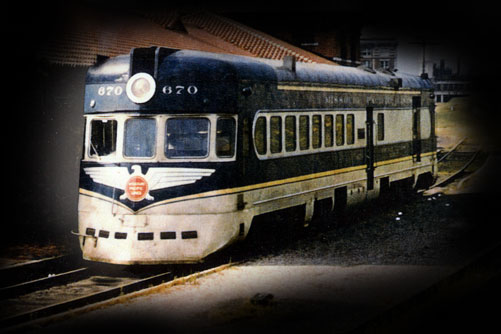
The
Eaglette MotoRailer #670
Much
of the following was provided by the generous efforts of Robert Soflin
Contributed material, including ALL photos, by Richard Andrews
- son of Missouri Pacific "Eaglette" Brakeman
Edited/Written by T. Greuter
Please read Michael M. Bartles' book "Missouri Pacific
River and Prairie
Rails"
One
of a Kind
With the dawn of the Eagles, the Missouri Pacific inaugurated its'
dieselization by provided the latest in passenger service to St. Louis,
Kansas City, Missouri and Omaha, Nebraska. The Lincoln to Union, Nebraska
Branch had the proud distinction to be part of this new era thanks to
a unique motor train named the Eaglette. Beginning in 1942, the
Eaglette ran the 47-mile connecting service at a relaxed 1 hour
and 20 minute pace (operating as trains #605-606). At Union, across the
platform connections were made to the Eagle (operating as train
#5-105 westbound, #106-6 eastbound).
 |
|
MP 670 Graphic by T. Greuter
|
|
Road
|
Type
|
First
Number
|
Final
Number
|
Builder
|
Built
|
Retired
|
|
MP
|
MotoRailer
|
670
|
670
|
ACF
|
1942
|
1961
|
|
Offspring of the Eagle - The Eaglette
It was September 1942 when the Missouri Pacific pressed into service new
equipment as the connection to the still-new streamlined Eagle.
The bi-directional streamlined Eaglette (aka Eaglet,
depending on who's spelling you follow) MotoRailer, #670 was one-of-a-kind
on the MoPac, patterned after an earlier AC&F design used by the Susquehanna
Railroad.
The 75' long passenger/baggage self-propelled motor train,
was built by American Car and Foundry in 1942 under lot #2223 at their
St. Charles, Missouri facility, according to ACF staff engineer John.
A. Krug. #670 balanced both service and economy for the 47-mile Lincoln
to Union Branch, as a compliment to the Missouri River Eagle passenger
service. The MotoRailer seated 34 passengers (another source says 47),
weighed over 108,600 lbs (54.5 tons) and had a large baggage section with
a capacity of 10,000 lbs. It bounced and jolted it's passengers along
the line at a speedy 55 mph. The car was a perfect match to the Eagle's
colors, quickly earning it the nicname Eaglette (also called
Eaglet and Little Eagle). The motorailer epitomized modern
streamlined passenger service of the day on the branch.
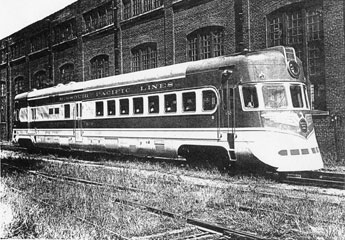 |
|
Two
ACF photos of the Missouri Pacific motorailer. ACF (American
Car & Foundry) built the car in 1942 under lot #2223 at
their St. Charles, Missouri facility. Both
builders photos show the car at St. Louis, Missouri, August
1942 - Richard Andrews Collection
|
|
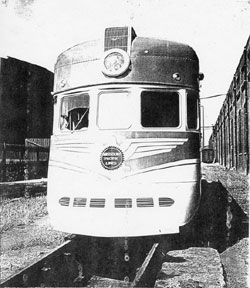 |
More than anything else the electrical ignition diesel-powered Motorailer
resembled an Eagle passenger car that operated like a streetcar. In appearance,
it was streamlined and rounded-smooth with an Egyptian-stylized spread-eagle
ornamentation on both ends, somewhat like the Eagle observation/tail cars
were. With operational controls at both ends it could run in both directions
-- just like a streetcar. Power was provided by a pair of 210HP Waukesha-Hesselman
engines. According to J. S. Mueller, Waukesha Engine Division, there were
three or four different four cylinder engines used in the motorailer application.
With the passage of time, the exact one used for #670 is now up to speculation.
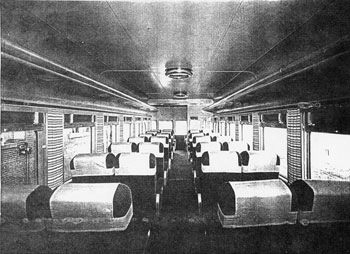 |
|
Coach interior
at St. Louis, Missouri, August 1942 - A.C.F. Photo / Richard Andrews
Collection |
In 1942, during the height of World War 2, Lincoln residents were captivated
by the unique vehicle. The Eaglet quickly achieved "celebrity status."
Residents, travelers as well as railfans were won over -- the motorailer
came to be an undeniable symbol of the Mopac in Lincoln. At a time when
luxuries were few and far between, passengers were treated to the comforts
of a streamliner while being able to view into the glass-enclosed engineer's
cabin. A four-man crew consisting of the engineer, brakeman, conductor,
and Railway Express agent were required to operate the 34-passenger capacity
unit. In the book "Missouri River and Prairie Rails" we have
the names and faces of the Eaglette crew from 1943: Pat Paterson, railway
Express agent; David Hamilton, brakeman; C. B. Goodwin, conductor; and
an unidentified engineer. D. H. Andrews, another brakeman for the Eaglette,
is not pictured.
The front windows of the cabin allowed passengers a whole new view of
rail travel, with unparalleled views of the scenic ride. Through the years
the motorailer survived the usual crossing accidents and the extremes
of Nebraska's weather. When unavailable, an older motorcar or even a steam
driven train (powered by an Atlantic or light Pacific) of one or two cars
would fill-in.
Eaglette Memories
The Eaglette was a definite hit with the local kid population, achieving
fame that would outlast it's all too brief career. A Lincoln-native now
living in Eagle, Bob Soflin writes "I grew up in Bethany Park in
the 50's... along the banks and in the depths of "Dead Mans' Run" ...
where I used to fish for crawdads under the creek bridge between Cotner
and 66th South of Vine. The banked curve between 56th and Cotner offered
many hours of pleasure walking the rails waiting for the Eaglette and
the daily freight. When no trains were expected the creek offered a diversion
and when that didn't entertain us we chased wayward golf balls on nearby
Park Valley Golf Course.
"Unfortunately, I also witnessed the horrible incident when the
Eaglet was late one winter evening and collided with a car at 66th before
any signals were installed."
"I loved the Eaglet and knew when she was coming every day. I got
to ride her to Union and back twice before they took her off. I also remember
seeing some steam freights and one time a circus train came through. "
But of all Bob's memories, one image stands out among the rest, "As
the Eaglet approached Cotner from 56th to me it was the most beautiful
thing I ever witnessed."
Over the dozen years of being assigned to the branchline, it became
evident that the motorcar's ability to handle the more severe snow drifts
of the "Siberian Sub" was less than adequate. During bad winters,
deep drifts forced the motorailer runs to a standstill.
When word got out the the Eaglette's Lincoln-Union service was to come
to an end, words of protest from the public reached the highest places.
One letter written to the Nebraska State Railway Commision stated that
no less than Paul J. Neff himself, MP's chief executive officer, heard
of the impending retirement from of the Eaglette in 1952. It so happened
that the motorailer was a long-time favorite of Neff's -- by the time
he had his say the Eaglette was immediately back in service and the official
responsible for it's early retirement was demoted.
Eventually, no doubt to the disappointment of the community, the seasonal
problem, and the decline in passengers due to improved highways forced
the Eaglette's task to be substituted by a more mundane MP bus at a lower
cost to the road. The last Lincoln-Union run, a twice-daily ritual for
a dozen years, occured on July 1954. But retirement wasn't in the picture
just yet.
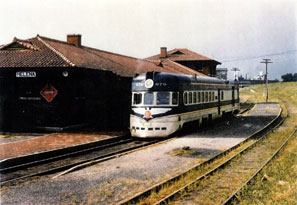 |
|
Now seen as the new Delta Eagle at Helena, Arkansas in 1956. With
a new Cummins motors and the roof painted all blue, as well as some
new exterior devices added. The #670 spent her last days on the Helena
to Memphis, Tennessee run. She'll be retired in five more years to
be scrapped. - Richard Andrews Collection |
Rebirth
-
as the "Delta Eagle"
At the same time the Eaglet's Lincoln-Union run was cancelled, the Delta
Eagle name was also dropped from the system timetables. MP 670 was sent
to MP's Sedalia, Missouri shops for an overhaul, completed in early 1955
with a pair of new Cummins 300-hp diesel engines and an Allison torque
converter. It's new assignment put it to work in the warmer climes of
the 97-miles Helena-McGhee, Arkansas run, inheriting the remnant of the
Delta Eagle (which became a new adopted name). Snowdrift dangers
were decidedly minimal here.
It wouldn't be until the decline of rail passenger patronage in the
'60's that the MotoRailer was at last retired. The reborn Delta Eagle
lasted to February 27, 1960, when the service faithfully ran it's last
passenger over the route. Sadly the one-of-a-kind Eaglette/Delta Eagle's
story ended at the scrapper's in 1961.
Coincidentally, long before the Missouri Pacific and Chicago & Eastern
Illinois were to become associated in any corporate way - The C&EI
Egyptian Zipper was assisted in it's schedule when need by a pair of ACF-built
motorcars - "Mount Vernon" and "Salem."
These two cars were very similar in design to the MoPac's own Eaglet.
Photos of all can be seen in Greg Stout's book, "Route of the
Eagles."
|
![]()

